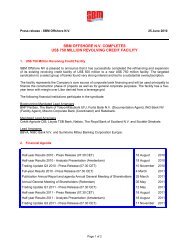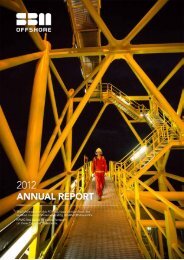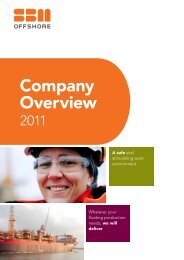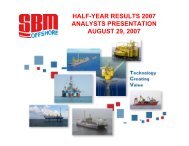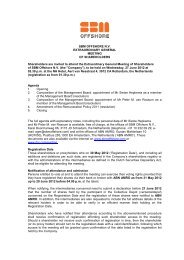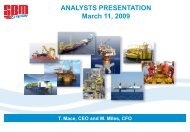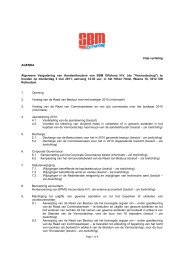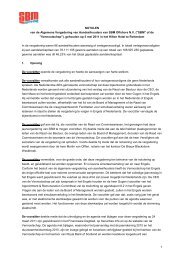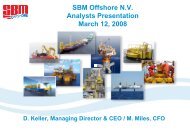2002 Annual Report - SBM Offshore
2002 Annual Report - SBM Offshore
2002 Annual Report - SBM Offshore
Create successful ePaper yourself
Turn your PDF publications into a flip-book with our unique Google optimized e-Paper software.
The monocolumn for the Matterhorn TLP, under tow<br />
in Singapore.<br />
The LPG and LNG markets<br />
With its success in obtaining an eight-year lease and<br />
operate contract for the Sanha LPG FPSO, the Group has<br />
reinforced its position as one of the leading companies in<br />
the supply of gas exploitation facilities. This contract<br />
creates a benchmark in the LPG segment, where it is<br />
expected that demand will grow considerably in the<br />
coming years.<br />
It is clear that global demand for LNG is going to<br />
increase, and export/import infrastructures are already<br />
being planned in the USA, Europe and South East Asia.<br />
In this segment, the two offshore developments which<br />
were expected to start in <strong>2002</strong> did not materialise. The<br />
project for Kudu in Namibia was suspended due to<br />
insufficient reserves, while the Sunrise project in<br />
Australia was postponed for political reasons.<br />
Nonetheless, a global demand for LNG infrastructures is<br />
An artist’s view of the SYMO ® technology applied to<br />
LNG floating plant for tandem loading of gas carriers.<br />
16<br />
expected to emerge soon. The objectives of IHC Caland in<br />
the LNG market are as follows:<br />
x to supply key, specialised components such as Soft<br />
Yoke Moorring and Offloading systems (SYMO ® ),<br />
turrets, swivels and mooring systems for floating LPG<br />
and LNG plants. It is most likely that the construction<br />
of such plants will be managed by the oil majors<br />
themselves, as they represent multi-billion dollar<br />
facilities;<br />
x to design and construct LPG and LNG FSO’s, and LNG<br />
Floating Storage and Regasification Units (FSRU’s).<br />
Here the Group will target the complete supply of the<br />
facility, possibly on a lease basis, as the contract value<br />
is similar to that of a mid-size oil FPSO. If turnkey<br />
supply is not required, the supply of key components<br />
will be pursued;<br />
x to supply mooring and transfer systems for loading<br />
and unloading terminals – always on a lumpsum,<br />
turnkey basis.<br />
Marketing efforts to promote the Group’s technology<br />
have already started, on the basis described above.<br />
<strong>SBM</strong>’s concept for a floating regasification plant (FSRU);<br />
an import terminal for liquefied natural gas.<br />
The Gulf of Mexico<br />
In previous reports, IHC Caland expressed its doubts<br />
about the highly optimistic predictions made by the<br />
press concerning FPSO’s in the Gulf of Mexico, as it was<br />
convinced that demand for FPSO’s would get off to a<br />
slow start. While last year’s <strong>Annual</strong> <strong>Report</strong> suggested that<br />
there might be opportunities in <strong>2002</strong>, no serious project<br />
is yet on the horizon. With E&P budgets in the USA being<br />
reduced, it remains to be seen whether 2003 will bring a<br />
real project. The requirement that all associated gas has<br />
eventually to be produced, and the fact that the Jones Act<br />
requires all shuttle tankers (not the FPSO) to be built in<br />
the USA are major economic obstacles. Business<br />
opportunities in the Gulf of Mexico will certainly not<br />
influence the future growth of the IHC Caland FPSO<br />
business in the short term.



